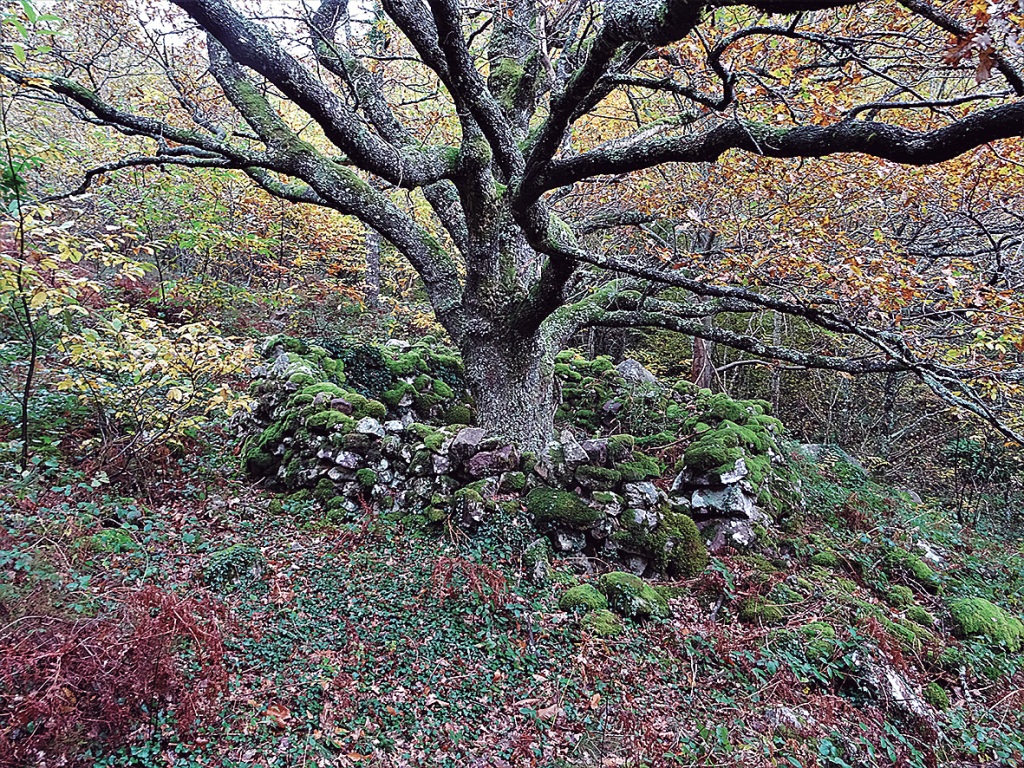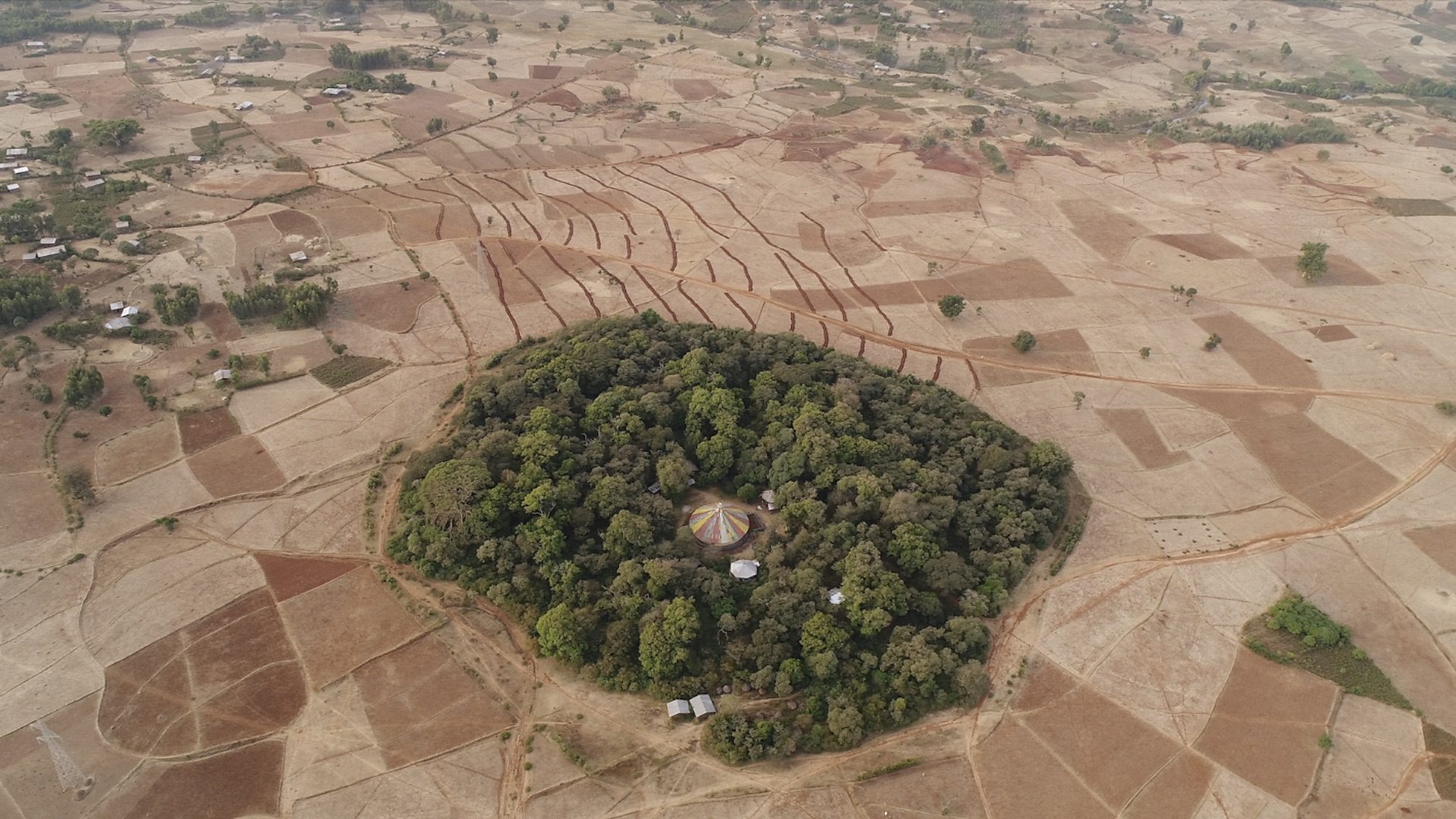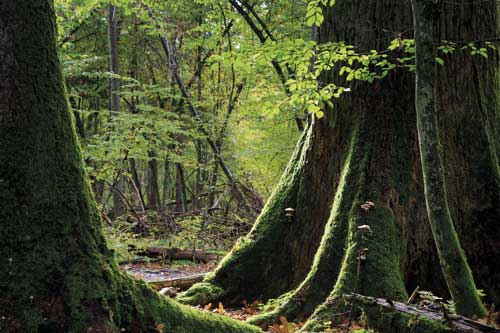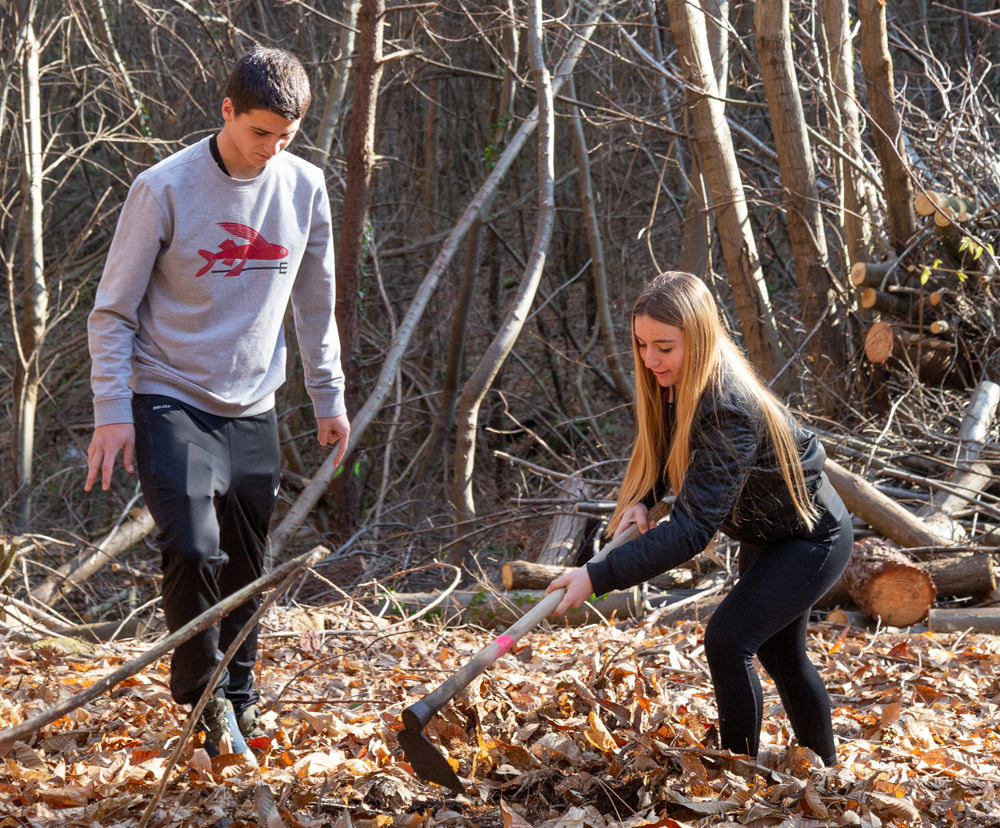Chestnut: cheap, hungry and healthy
- Autumn is at its peak. The corners are colored. Good time to walk on the mountain. On the ground, here and there, you can see the broadcasts between the leaves – ropes, arbots, moths, hedgehogs – that have fallen from the tree since September, especially in wet and dark areas. Brown, covered with thorns, they do not look excessively attractive, at least for those who do not know that they keep the seed inside, a precious food for the cold months: chestnut is high. Come, come, girl to children's house / to eat chestnut...

Today they are barely in Euskal Herria a series of tall chestnut trees. The current distribution of the species does not show the ecological, economic and cultural importance this tree has had, since its expansion area is largely occupied by rapidly growing conifer plantations. Although the use of chestnuts has also been lost in gastronomy, there are still celebrations of Gaztainerre, Gaztainada, Gaztainada, Gaztaina, etc., which give value to the history of this food.
So what is the real situation of chestnut trees in Euskal Herria today? What has their management been like throughout history? What legacy has this custody left us? Where do the chestnuts we consume today come from?
.jpg)
Bread of the poor
It has long been discussed whether chestnut was introduced by the Romans in the Basque Country. It is now recognized that the Cantabrian regions were the refuge of this species during the last glaciation, some 26,500 years ago; but it is also true that, since the Iron Age (some 3,000 years ago) and, above all, after the Romanization (2,000 years ago), chestnut spread widely, probably related to human needs. In this sense, it is very significant that in the Bidasoa estuary, chestnut pollen of this time were found along with cereal residues, as it shows that it was a product already integrated into the agricultural system.
Chestnut has long been available to Basque companies. Its historical evolution has materialized in the symbiosis with the closely interrelated human being, until it becomes a tree almost “home”. Although it also grows spontaneously, seminars were very common both in the villages and on popular grounds, and over the centuries increasingly sophisticated techniques were developed to make changes and grafts effectively.
As with all species cultivated by humans, there are a multitude of different varieties of chestnuts throughout the Basque Country. These move from the locality to the locality, being able to distinguish taking into account the characteristics of the locust or the number of chestnuts: The “ulezuri”, for example, has white strings, while the “braids” are usually chained; the “triples” bear three chestnuts by arbots and the “great father” a single large chestnut. Each of them is the result of a certain selection process – and hybridization – that have served different functions.
The main use of chestnut has been food, both human and animal. Father Larramendi wrote in 1754 that in Gipuzkoa the chestnut was of great help to the dwellings and lowly people, with whom they were fed greatly. At the same time (1764), Voltaire said that in many provinces of France, chestnuts were barely eaten. A century later, Joan Ignazio Iztueta established: “In Guipúzcoa there is echeac, ascents and ascension, six or seven castañetales locked in their term and that in the morning they sell to the nao, chiqui arqui everything that is eaten and sold to the irurogueras anega ta gueiago azoquea. The whole demarcation of the Onetas Provinces is chestnut toquia; and the good grain of the good is elduric jalquia, she is food and jaquia”. (Guipuzcoaco Provinciaren Condaira or Historia, 1847).
In the 18th century chestnut was the basis for feeding the poorest in the long winter months
In his opinion, the chestnut was “a crumb of merquee, hungry, healthy, inic, some salt and other seasoning, a bacarric berarequín is prepared for food.” The fruit could be eaten cooked or roasted in the tamboril or in flour to make the so-called “bread of the poor”. These gastronomic practices also correspond to those documented in other European mountain countries: In Auvergne, Périgord, Galicia, Corsica or Brittany, to cite just a few examples. In all of them, chestnuts were the basis for feeding the poorest for long winter months.
A culture of chestnut
Eating fruit has not been the only use of chestnut. Although it was not considered suitable for coal, the tree wood was also appreciated, as it is waterproof and very durable. A toxin called tanino was extracted from the trunk surface; in 1750, an ordinance of the kingdom of Navarra influenced the need to protect chestnuts, an essential material for the tanning of hides and skins and to prevent the rotting of ropes and naval networks. In summary, it can be said that in Euskal Herria, as in many other places, there was a whole structured culture around chestnut.

In our mountains there are still witnesses of these old uses. Chestnut mentions are very abundant in toponymy: most are generic — Gaztañadui, Gaztañeta, Gaztañaga and others — but sometimes they also show concrete practices: The name Gaztainmotxa (Oiartzun), for example, is probably a benchmark in the coal industry. There is also no shortage of toponyms that tell us about the chestnuts exploited by the church: Gaztañabedeinkatua (Segura), Abadegaztañeta (Amorebieta-Etxano) and Arimengaztañadia (Ziortza-Bolibar), for example. In Debagoiena it is noteworthy: A Gaztañamintegra in Oñati, an Auzogaztañeta in the anteiglesias of Larrino (Aretxabaleta) and Marín (Eskoriatza), and an Auzogaztañadui in Mazmela (Eskoriatza) and Bedoña (Arrasate). Would they plant chestnuts in the villages of yesteryear, perhaps, in a position to be used by all the neighbours? It is difficult to say, but in Geneva (Navarra) this type of practice is already known.

They highlight the old chestnuts that have been scattered here and there, some truly monumental. Small, round and square enclosures made with a stone wall are also common. Resurrection María Azkue collected the words “corral” and “cortina” to refer to these elements. In Sara, Joxe Miel Barandiaran named them “castaños”; “espille” has also been documented in Baztan. Variants such as the “kirikiñausi” are used in the Gorbea area. They were involved in several points of Gipuzkoa, such as the grehes of the Aosta Valley in Italy, and they are called “gaztanbordas”.
In autumn, when the lochas fell, they were stacked inside the tespiles and covered with ferns, thorns or dried leaves to prevent the animals from eating them. In this way, they remained in good condition over the next few months.
These structures served as a storage for chestnuts. In autumn, when the lochas fell, they were stacked inside the tespiles and covered with ferns, thorns or dried leaves to prevent the animals from eating them. In this way, they remained in good condition over the next few months, in order to gradually leave according to the needs of the house. In some cases, chestnuts (wilts?) Until the next spring, they could already feed.
Research projects and the value of this mountain heritage have been announced in recent years. Thanks to the work carried out in the Gorbea Natural Park, for example, 36 hespiles have been invented, and the Orozko City Council has created a route for public dissemination. These elements are also known in Baztan; the first investigations have allowed the identification of at least 8 specimens. In the skirt of Hernio there are also examples in Zelatun, but in this case without any kind of inventory; there is no doubt that there is still much to explore around the mountain heritage.
Chestnut disease
In the last quarter of the 19th century he severely hit the so-called zapbeltza diseases and almost destroyed chestnut trees.
But chestnut is virtually missing in Euskal Herria. The consumption of chestnuts and the care of chestnuts have decreased significantly in the last century, to the point where the memory of this ancient culture has remained virtually ineffectual. Many factors have influenced this decline, and it seems that the social stigma of eating chestnuts for the most humble classes. The critical moment certainly came in the last quarter of the 19th century, when the chestnut was severely hit by the disease.
This plague has been called in Basque the black foot, in Spanish ink and in French encre, since its most visible consequence was the necrosis of the tree roots, to the point of causing the death of the specimen. In order to know the origin of the disease, the deputies of Bizkaia, Gipuzkoa and Navarra commissioned an investigation to J.M. Scientist Goikoetxea Altzuaran. The conclusions of this work were presented at a conference on March 16, 1900 in San Sebastian, and that same year the Printers of the Province of Bizkaia were published.
According to the report, the first signs of the epidemic appeared on the Biscayan coast in 1871 and 1872, and in 1876 it appeared documented in Ondarroa, Mendexa, Berriatua, Amoroto and Lekeitio. On the other hand, in Lapurdi, it appeared for the first time in 1883 in Sara and Senpere; in Zuberoa, in 1998, it appeared in Atharratze. Thus, although at first the epidemic spread slowly, at the end of the nineteenth century there were already many chestnuts from all over the Basque Country affected by the disease, concerned both by local communities and by political leaders.
Goikoetxea identified a fungus of the genus Phytophthora as the source of the disease he suffered. This mushroom attacked the chestnuts, spreading them mainly in the foothills of the mountains and in the most fertile and humid valleys, the most suitable places for the cultivation of the chestnut. To address the situation, he proposed the following solutions: 1) increasing distances between trees to avoid contamination; 2) collecting and burning leaves, fruits, etc. fallen; and 3) wet chestnut with copper sulphide, as was done with the vineyards of Bordeaux. This type of chemical treatment would continue to develop in the early twentieth century, especially in the 1940s. Through the new methods proposed by the agronomist engineer Urkixo Landaluze.
Another way to avoid the disease was the attempt to create resistant chestnuts, through the integration or hybridization with native chestnuts of Asian varieties sent to Aldude in 1907 by several Japanese missionary ecclesiastics. The experiments were carried out on both sides of the border. In the Northern Basque Country, G. de Lekorne. Lafitte began to test vaccinations in its departments in the 1930s; in Hegoalde, we must again mention the Biscayan Urkixo Landaluze, for his work as director of the Plant Pathology Station of A Coruña in the 1940s.
In the past, chestnuts were alternated with other types of forests, forage areas, ferns or otadians.
These attempts do not seem to have been too successful. On the one hand, from 1947 onwards, the chestnuts of the Basque Country suffered a new disease: chancre, also caused by fungi. On the other hand, the traditional rural economy based on the overlap of the various activities and actors had already begun to decline. In the past, chestnuts were interspersed with forests of other types, forage areas, ferns or otadians, but as the twentieth century progressed, these complex mosaics were gradually replaced by single-specific plantations, especially pine forests, to the detriment of biodiversity. Consequently, the capacity of mountain ecosystems to cope with pests, natural disasters and other crises was severely diminished.
As erosion increased and the economic instability of local communities increased, short-term strategies based on intensive management models that increasingly severely affect the environment have been imposed in recent decades. Its risks are obvious; in view of the pine disease that has raised all the alarms in 2018, what happened with chestnut should offer us valuable insights. Have we learned the lesson?
Azken mendean Etiopiak galdu ditu antzinako oihanik gehienak, nekazaritzaren, artzaintzaren eta herrialdean laborantza industrial neokolonialak eragindako goseteen presiopean. Alabaina, biodibertsitatez betetako azken baso zatiak geratu dira, fosil gisa, zientoka eliza eta... [+]
Would anyone say that the Amazon rainforest is an abandoned forest? Or that the protected areas of Costa Rica and Borneo are abandoned? Have we declared natural parks because Pagoeta and Aiako Harria are abandoned forests? In all these areas is the natural forest or the natural... [+]
The dandelion tooth flourishes (Taraxacum officinale). Most flourished towards March, and a few flourish further. And here and there you will find your attractive yellow flower for almost all the year. Its open flower is a sign of good time. It had been extended from day to day... [+]
On the day of the presentation of book 111 Hostoz eta Orriz we had the opportunity to learn about the culture of Duzunaritz. A delicious day to round off a series of celebrations that fill the century of Argia. I can't imagine a more beautiful path than to dirty the shoes in... [+]
This morning the woodpecker screamed in the oak of the house (Quercus robur). He'd been a long time, and he seemed angry. The morning is beautiful, fresh but joyful, very clear. We approach the longest days of the year and it is noticeable in the brightness of the morning. But... [+]
Anyway, in good and bad ways, we have been told that we sharpen all the threats, but we have been told five. The world, our world is dying. Our way of life is unsustainable and unsustainable for all the other living things that have touched them to live with us. Every day we are... [+]
Pollination is important in the way of life of most plants. Essential to create a seed that builds the future of each species and variety. Pollination is a journey from the Pollen Aleño de la Flor to the Female. This travel can be done on the body, head, or legs of an insect,... [+]























